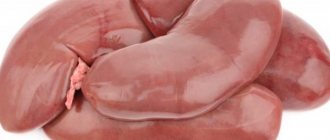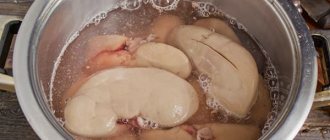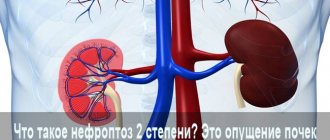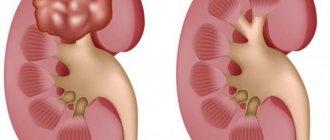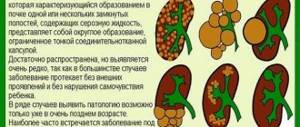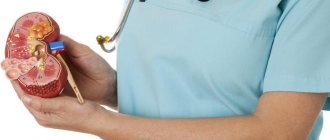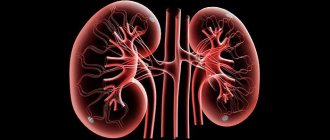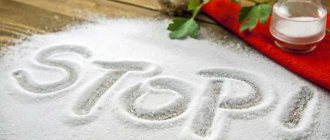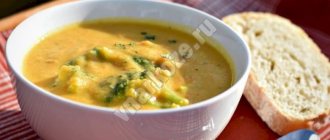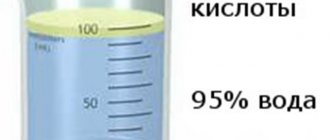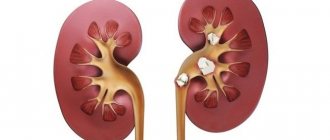Hydronephrosis is translated from Greek as “water in the kidneys”; it is popularly called dropsy. The disease can be congenital or occur during life, and is characterized by dilation of the renal pelvis and atrophy of parenchymal tissue due to impaired urine outflow, as well as increased blood pressure. Against the background of stagnation of urine and the addition of infection, acute renal failure and other pathologies may occur. Diet for hydronephrosis is indicated at the initial stage of its development and is one of the methods of conservative therapy.
Why diet is so important
The functioning of the entire body is highly dependent on the functioning of the kidneys, because it is thanks to them that the body uninterruptedly filters all incoming fluid. Due to expansion, these processes are disrupted, the kidneys lose their functions, and then the body does not have time to get rid of all harmful substances. Poor kidney function can leave creatinine and urea behind, and too much of these in the body is incredibly harmful. Nutrition during hydronephrosis cannot be neglected, otherwise the person will suffer irreparable consequences, from coma to death.
The nephrologist will prescribe an organized and properly selected diet that helps eliminate toxins, improve the general condition of the body and properly saturate it with organic resources. It’s worth figuring out which dishes are worth paying attention to in the fight against kidney disease.
Why is the diet prescribed?
If the functioning of the kidneys is impaired, urine stagnates in the renal pelvis, processed metabolic products cannot be fully excreted and accumulate in the body, and general intoxication develops. In patients with severe hydronephrosis, renal failure is diagnosed, which poses a threat to human life.
If timely excretion of urea and creatinine along with urine does not occur, then these metabolic products enter the blood.
The central nervous system is damaged, brain function is disrupted, and encephalopathy develops.
A diet for kidney hydronephrosis facilitates and accelerates urine excretion and helps restore the function of the affected organ. A properly formulated diet promotes detoxification and supports the functions of the cardiovascular system.
Fluid due to hydronephrosis
The question “how much should you drink for hydronephrosis” cannot be answered unambiguously. Drinking too much puts unnecessary pressure on the kidneys and can even stretch the pelvis and calyces further. However, drinking too little is also not beneficial, because liquid during hydronephrosis removes excess metabolic products. It is worth choosing a middle ground - about 1 liter per day.
It is best to give priority to regular water. It is allowed to drink weakly brewed teas, compotes and diluted juices. Many also drink herbal infusions such as nettle, string and chamomile, but you should first seek permission from a doctor.
Among other things, you can even drink wine during treatment. Moreover, it has been scientifically proven that 200 grams of red wine has a beneficial effect on kidney function - better than juices or teas.
Drinking regime
With hydronephrosis, patients should carefully monitor daily diuresis. Taking into account the volume of urine excreted, they calculate how much liquid you can drink per day. A patient's daily intake of water should not exceed yesterday's diuresis by more than 0.5 liters:
- Vurine + 0.5 l = allowed amount of liquid.
Any liquid is taken into account, including compote, tea, broth, soup. It is best to drink mineral, bicarbonate water; it is useful to drink herbal teas, non-concentrated freshly squeezed juices diluted with water 1:1.
Fasting days
It is recommended to combine fasting days with observation by a doctor. They consist of special diet complexes, such as:
- Compote diet: consume 200 ml five times a day;
- Watermelon diet: eat 250-300 grams of watermelon every 3 hours;
- Fruit diet: the same as with watermelon. You can use any fruit;
- Vegetable diet: its main dish is salads. You need to consume 1.5 kg of vegetables per day, divided into 5 meals.
This style of diet will not only improve your well-being, but also speed up your metabolism, which is very important for recovery.
Dietary nutrition for the diagnosis of “Hydronephrosis”
The diet for kidney hydronephrosis is specific, so only the attending physician sets the nutritional rules; he also determines which foods should be included in the diet, and what should be completely abandoned or limited. At the same time, he takes into account the patient’s well-being, age characteristics, individual characteristics and contraindications.
The importance of proper nutrition for successful treatment
With hydronephrosis of any degree due to stagnation of urine in the renal pelvis, the process of natural removal of decay products slows down significantly. This leads to their accumulation, against the background of which slow intoxication of the body occurs. In severe forms of hydronephrosis, acute renal failure, pyelonephritis, encephalopathy develop, the nervous system is damaged, and brain function is disrupted. Pregnant women experience delays in fetal development.
It is important to know! A diet for renal dropsy, especially bilateral, facilitates and accelerates the excretion of urine, helps to partially restore the damaged lost functions of the paired organ. A properly formulated diet allows you to maintain normal functioning of the cardiovascular system and at the same time detoxify the body.
When the process is sluggish, table No. 7 according to Pevzner is shown - the basis for creating many different nutritional plans for kidney diseases. It is equally suitable for an adult, a child, a pregnant woman, especially those prone to swelling and those suffering from metabolic disorders. The therapeutic diet for bilateral kidney hydronephrosis involves split meals, increasing the calorie content of food and reducing fluid intake to 1.5 liters (this volume includes first courses). The protein component of the diet is formed from animal proteins. The energy value per day should be maintained at the level of 2700-3000 Kcal.
Products that are allowed
A specific feature of diet No. 7 is the consumption of large amounts of fresh foods. Vegetables and fruits should be included in the daily menu, and the daily volume should not be less than 400-500 g. Protein content is also limited - no more than 0.5 g per 1 kg of patient weight. If diuretics are prescribed, then foods rich in these elements will help replenish the loss of potassium, magnesium and calcium.
The list of recommended products is quite diverse.
- Vegetables and greens - potatoes, beets, cauliflower, pumpkin, tomatoes, dill.
- Fruits and berries - apples, figs, melon, watermelon, strawberries.
- Cereals – sago, white rice, buckwheat.
- Fermented milk products - kefir, cream, sour cream, milk, curdled milk, yogurt.
- Fats – butter, as well as vegetable oil – corn, olive, flaxseed.
The daily diet should include a choice of low-fat fish, boiled veal, beef, beef tongue, rabbit, turkey or chicken. It is recommended to use sugar, honey, cumin, dried dill, sour cream or milk sauce as useful ingredients and additives.
Harmful foods for the kidneys
Doctors advise patients with pathologies of the urinary system to exclude from the diet foods that promote stone formation and the development of inflammatory processes, increase the load on the damaged organ and irritate it. Therapeutic nutrition for hydrocele of the kidneys involves the exclusion of table salt and products with a high content of it - smoked meats, sausages, marinades, pickles, hot cheeses, seasonings, spices. The use of concentrated meat and fish broths is not recommended.
The approximate list of restricted products is also quite wide.
- Vegetables – garlic, onions, turnips, white radish, celery, sauerkraut, horseradish.
- Greens – sorrel, spinach, cilantro.
- Fruits - bananas, apricots, peaches, nectarines.
- Mushrooms of any variety.
- Cereals – semolina, oatmeal, corn, millet, pearl barley.
- Seasonings – mustard, ketchup, mayonnaise, tomato sauce, black pepper.
- Drinks – coffee, black tea, soda, energy drinks, alcohol (vodka, cognac, beer).
Chocolate, pasta, fatty meat, and sausages should be completely eliminated from consumption.
Fluid intake
There are no special instructions for correcting the drinking regime. Experts have different opinions regarding the optimal daily volume. Some believe that drinking plenty of fluids is necessary to speed up the process of removing toxins from the body. Others argue that this will increase the load on the kidneys and lead to serious problems, including rupture. Therefore, it is believed that if you are prone to edema, fluid intake should be reduced to 800 ml-1.5 liters per day. If there is no problem with moisture retention, then it can be increased to 2-2.5 liters.
Advice! It is recommended to drink mostly clean water without gases; sometimes weak tea or coffee is allowed. For variety, you can consume sour compotes, fruit drinks, and juices. Decoctions and infusions of marshmallow, bearberry, knotweed, birch and raspberry leaves, calendula and chamomile flowers are considered beneficial.
The need for fasting days
To restore normal well-being and improve urine flow, it is useful for patients to arrange fasting days. There are many different options.
- Vegetables. They involve eating exclusively fresh vegetables. You can prepare a variety of salads from them with the addition of olive or flaxseed oil. It is recommended to eat food 5 times a day, the amount of 1 serving should not exceed 300 g.
- Fruity. The above-described consumption pattern is considered optimal, only instead of vegetables, berries, fruits, and citrus fruits are used (in the absence of allergies). Useful - gooseberries, raspberries, cherries, grapes, apples, oranges.
- Watermelon. Only ripe, juicy berry pulp is suitable for consumption. It can also be eaten 250-300 g 5-6 times during the day. Compotes made from fresh berries or fruits (1 liter of liquid in five doses) are suitable for this purpose.
This method of therapy allows you to effectively combat edema, remove harmful components and processed waste products, and replenish the deficiency of magnesium, potassium, calcium, and sodium. But, despite the apparent benefits of fasting days, you should consult a specialist before carrying them out. In the presence of pathologies such as renal failure, hypertension, increased stress on the organ is contraindicated. With urolithiasis, these measures can lead to blockage of the excretory duct.
Features of the diet and cooking rules
You need to eat little and often. It is advisable to divide the entire volume of daily food into 5-6 meals. You should not overeat at night; it is better to eat something light for dinner.
For the first course, vegetarian soups with the addition of vegetables and cereals are allowed. For second courses, it is recommended to use low-fat varieties of veal, fish, dietary turkey or chicken. As side dishes, you can use stewed or fresh vegetables seasoned with vegetable oil, sour cream, and yogurt. To improve the taste of unsalted food, it is recommended to use milk-based sauces. Allowed drinks are green teas, herbal infusions, rose hip decoction, and fruit juices.
It is important to know! Culinary processing of products is varied, since it does not involve mechanical sparing. Dishes can be stewed, baked, boiled, steamed. However, the basis of the diet should be fresh foods.
Sample menu for the week
Since the main limitation is the consumption of salt, experts advise mastering the profession of a baker and preparing baked goods with various additives - vegetables, fruits and dried herbs. A sample menu for a week for hydronephrosis is as follows.
| Breakfast | Lunch | Dinner | Afternoon snack | Dinner | |
| Monday | Buckwheat porridge Poached egg Homemade bread Tea with honey | Baked apples with jam | Borscht with prunes and sour cream Boiled meat Vegetable stew Compote | A glass of apricot juice | Lapshevnik with cottage cheese and sour cream Carrot-apple puree with jam Tea with milk and sugar |
| Tuesday | Oatmeal milk porridge with butter Cottage cheese Tea with sugar | Unsalted cookies A glass of fruit and berry juice | Rice soup with vegetables Boiled chicken with sour cream sauce Mashed potatoes Rosehip decoction | Dried fruit compote Homemade baking | Millet porridge with raisins Fruit jelly |
| Wednesday | Rice porridge Cottage cheese tea | Peach juice Raisin cookies | Vegetable soup with sour cream Boiled fish with sour cream sauce Steamed rice A glass of juice | Compote Butter bun with jam | Krupennik with pumpkin, carrots and apricot jam Milk |
| Thursday | Omelette with vegetables Homemade bread Butter Tea with condensed milk | Pumpkin porridge with rice and raisins | Soup with buckwheat and potatoes Boiled fish Stewed vegetables compote | Plum juice Butter cookies | Lapshevnik with cottage cheese and jam |
| Friday | Steamed omelette Sweet cottage cheese with raisins Milk tea | Pumpkin with apples, raisins and cinnamon | Brussels sprouts soup Baked chicken Buckwheat Kissel | Rosehip decoction Baked pie with dried fruits | Cottage cheese casserole with carrots Homemade bun Fruit juice |
| Saturday | Cheesecakes with jam Cookies with raisins Tea | Baked apples with dried apricots | Lenten cabbage soup Boiled beef Caviar from vegetables Compote | Grape juice Cookies | Rice casserole with pumpkin and carrots Kefir bun |
| Sunday | Poached egg Unsalted cheese Tea with condensed milk | Fruit juice Dietary crispbread | Vegetarian borscht Boiled turkey Millet porridge Kissel | Rosehip decoction Sweet baked goods | Lapshevnik with cottage cheese and carrots Cup of tea. |
Recipes for tasty and healthy dishes for hydronephrosis
Properly prepared tasty and healthy dishes can diversify any diet so much that a person adhering to therapeutic nutrition will not notice the existing restrictions. Their creation is not difficult even for novice cooks.
Lapshevnik with cottage cheese
Ingredients for 3 servings:
- pasta of any kind - 120 g;
- dietary cottage cheese – 180 g;
- chicken egg – 1 pc.;
- sour cream – 10 g;
- sugar – 2 tablespoons;
- breadcrumbs - 1 tbsp. l.;
- sour cream for serving;
- butter for greasing the mold.
Process of creation:
Boil the noodles and drain them in a colander, then transfer them to a deep bowl and combine with cottage cheese and sugar. Add the egg, mix everything thoroughly. Preheat the oven to 200°C. Grease the mold with butter, sprinkle with breadcrumbs, and lay out the finished mixture. Spread sour cream on top in an even layer. Bake the noodle maker for 30-35 minutes until golden brown. Serve with jam.
Krupennik with pumpkin
Ingredients:
- millet – 1.5 cups;
- Pumpkin pulp – 0.5 kg;
- Breadcrumbs - 3 tbsp;
- Butter – 100 g;
- Milk – 0.5 l;
- Mayonnaise – 200 g;
- Chicken egg – 1 pc.;
- Sugar to taste, salt on the tip of a knife.
Preparation:
Rinse the cereal, add a small amount of water and place on the stove. After evaporation, add milk and cook over low heat until cooked. Put a third of the oil and 1 tsp. Sahara. Cut the pumpkin pulp into cubes and simmer in oil until softened. In a bowl, beat the egg with milk and mayonnaise. Combine the porridge with the remaining ingredients and mix carefully. Place in a greased and breadcrumbed pan and bake at 200°C for 20 minutes. Serve hot with cold milk or tea.
Diet price
The diet may not be too varied and will definitely not appeal to those who like fatty and salty foods, but it will have a good effect on the well-being and general condition of the body. In addition, eating mostly vegetables and fruits will have a positive effect on the budget - as a rule, culinary delights from these products are not too expensive.
Hydronephrosis will not be cured overnight with proper nutrition alone, but a long-term diet has a beneficial effect on the functioning of the affected kidney and significantly speeds up recovery.
Diet rules
The basic rules for organizing a diet for hydronephrosis are as follows:
- Fractionation of meals, the weight of one meal is no more than 300 g.
- Monitoring fluid intake.
- Reducing the consumption of dishes such as soups and jelly, that is, containing calories and water at the same time.
- No separate meals. The meal contains proteins, fats and carbohydrates.
- Control your sodium intake. A salt-free diet is not recommended, but a reduction in salt intake is required. The amount should be recommended by the doctor in a particular case.
- Eating food at the same time.
- Fasting days are done only on the recommendation of a doctor; amateur activities in this matter are not allowed.
- Prohibited products are completely excluded. Those that are not recommended can be eaten 1-2 times a week in small portions
Please note: all dietary supplements, supplements, some kind of kidney teas, weight loss drugs and meal replacements must be approved by your doctor. It is not recommended to take sports nutrition, except for amino acid complexes and vitamins, strictly without fragrances, preservatives and dyes. All this is food that is not recommended for patients.
Diet 7b. Dietary table No. 7b
7b dietary table is prescribed for nephritis of any form, which is accompanied by an increased content of nitrogenous metabolic products in the patient’s blood, chronic renal failure, edema, and high blood pressure.
The goal of the diet is to reduce edema, arterial hypertension, reduce inflammation, and restore nitrogen excretion function of the kidneys.
How to eat properly according to diet No. 7b for chronic renal failure
For people suffering from kidney failure, especially in chronic form, as well as for those who have an excess of nitrogenous wastes retained in the body and poorly excreted, a properly chosen nutritional system is sometimes crucial for quickly relieving the inflammatory syndrome and restoring normal functioning such important organs as the kidneys and the entire urinary system as a whole.
The treatment table developed by Dr. Pevzner 7b also helps patients get rid of excessive swelling, weight, and spikes in blood pressure.
7b dietary table is characterized by:
- The almost normal calorie content of food is up to 2600 kcal per day.
- Five to six meals a day.
- In total, you can eat up to 2.5 kg of dietary food per day.
- All dishes are prepared without adding sodium salts. Daily consumption of 2-3 grams of salt contained in food is allowed.
- The presence of proteins in food is allowed to be twice as high as in diet 7a. Their quantity can reach 45-50 grams. Proteins should be predominantly of animal origin - up to 60-70%.
- Cottage cheese, up to 125 gr. per day, should be alternated in the diet with the same amount of fish or meat.
- The amount of carbohydrates is within the physiological norm – up to 450 g.
- Bread and bakery products must be salt-free and protein-free. It is best to cook bread with cornstarch.
- Fats, a quarter of which are vegetable, can be present in the daily amount of food in an amount of about 90 grams.
- It is recommended to eat 0.7 to 0.9 kg of vegetables and fruits every day.
- The total amount of carbohydrates includes the daily sugar intake of 100 grams.
Treatment using traditional medicine methods
To speed up the healing process, you can use herbal teas, herbal teas and decoctions. Various medicinal plants will be useful for kidney diseases:
- Birch leaves
- Bean flaps
- Dandelion root
After consulting with a doctor, you can start drinking decoctions or infusions. Some patients cannot take bitter herbs such as wormwood, licorice and elecampane. As part of the collection, the bitterness will appear no less.
Full recovery occurs a year after the start of treatment for hydronephrosis. For the diet to be beneficial, you must always adhere to the recommended diet. If you allow yourself to consume prohibited foods, the disease can become acute.
What to do during complications?
The diet for hydronephrosis of the right kidney, as well as the left, with the development of various types of complications, provides additional tips and restrictions:
- With the development of pyelonephritis, it is necessary that fruits and vegetables predominate in the menu; liquid should be drunk in an amount of at least 2 liters per day.
- If uremia develops, the use of salt and protein is limited. If blood pressure is high, salt should be completely avoided. For such patients, a diet with sufficient calories is needed.
- The presence of kidney stones requires drinking plenty of fluids.
Nutrition for hydronephrosis in children is practically no different from that in adults. The diet must be carefully thought out and balanced. Be sure to use products containing vitamins and essential elements.
Dietary recommendations for hydronephrosis are general and informational in nature. With this disease, it is especially important to consult a doctor who will help in each case individually, taking into account the characteristics of age and general condition, as well as based on the stage of the pathological process, to select the necessary diet so as not to harm the patient’s body.
Diets for hydronephrosis of any of the kidneys, if complications occur, have additional restrictions:
- if stones are found, more fluids are required;
- uremia will force the patient to do without salt and reduce protein foods to a minimum;
- pyelonephritis means you will need to drink more (up to 2 liters per day) and revise the menu in favor of vegetables and fruits.
The diet for children with hydronephrosis is no different from that for adults, but should be more balanced and supplemented with vitamins. It is clear that even knowing the basic principles of the diet, there is no need to risk your health and promptly seek qualified help from a doctor. Only an individual approach, taking into account all the characteristics of each individual case, will allow the selection of a diet.
Liquid intake regimen
If you are prone to swelling, it is recommended to drink fluid (including soups) in the range of 0.8-1.5 liters per day (check with your doctor). If there are no problems with edema, then fluid consumption increases to 2.5 liters. Water is taken in small portions throughout the day.
Try to drink mostly clean water. Weak tea and coffee, sour compotes, fruit drinks, and juices are acceptable. Herbal infusions are also useful. The doctor should tell you which plants to use for their preparation. But these are: dandelion roots, marshmallow, raspberry leaves, birch leaves, knotweed, bearberry, chamomile flowers, calendula.
Fasting days can be spent on compotes of fresh berries and fruits, drinking up to 1 liter per day in 5 divided doses. Or on watermelons, eating a couple of slices every 2.5-3 hours with a total weight of 250-300 g.
General recommendations for patients
Hydronephrosis can be either a congenital disease associated with the structural features of the urinary system, or acquired. Proper nutrition for hydronephrosis involves eating vegetables and fruits in large quantities. You should not eat too much food containing animal protein. But if you eat only vegetables and dairy products, a favorable environment is created for the formation of phosphate stones.
The norm of water consumption is 2 liters per day, excluding liquid obtained from fruits. If the disease is in a severe stage - the daily norm is 1.5 liters, you need to drink in small portions. It is better not to drink coffee, only weakly brewed tea.
It is important to get enough calories every day - from 2,400 to 3,000 Kcal. Changes can be made to the menu; the diet is prescribed by the doctor to the patient individually. Strict restrictions are imposed only in case of bilateral kidney damage.
Symptoms of the disease
There may be minor or severe pain in the lower back, aching pain or tingling.
The early stages of hydronephrosis may not manifest symptoms. There may be minor or severe pain in the lumbar region, aching pain or tingling. In any case, pain occurs only in the area of the affected kidney (left or right). Sometimes the pain may radiate to the groin or leg.
Attention! The longer hydronephrosis lasts, the less pain becomes due to organ atrophy. Relieving pain in the kidney area is a reason to urgently consult a doctor.
Along with the pain, there may be attacks of nausea, vomiting, increased blood pressure or body temperature. The presence of an elevated temperature indicates the addition of an infectious infection. In one out of five cases of hydronephrosis, blood in large or small quantities may be observed in the urine of patients (microhematuria). Microhematuria is diagnosed only using laboratory tests (red blood cells). At the last stage of hydronephrosis, due to renal failure, swelling of the body develops, the volume of urine decreases significantly, and arterial hypertension and anemia develop.
Menu for kidney disease. Basic recommendations
After the kidney pathology is confirmed, the doctor prescribes treatment, which includes a renal diet, namely a low-protein diet, which, according to urologists, is the most effective. Diet for kidney disease should exclude the consumption of salt and protein as much as possible. If possible, it is necessary to avoid salt completely, since this product inhibits the process of removing fluid from the body, and this is fraught with such unpleasant consequences as the formation of sand in the kidneys.
Dietary recommendations for kidney disease
A diet for sick kidneys should be based on the following principles:
- you can eat only in small portions, at least five meals a day;
- stick to a nutritional schedule;
- the amount of liquid drunk is reduced to 1.5 liters;
- It is necessary to salt dishes after cooking; there is no need to do this during the cooking process;
- do not add onions, garlic and spices to food;
- exclude fatty foods, as well as foods that are hard on the kidneys;
- eat more vegetables and fruits.
Following the above rules will significantly speed up recovery. It is important to maintain a regular diet; there should be no concessions.
Nutrition for kidney disease includes an increase in the number of foods that have diuretic properties, that is, they have a diuretic effect: zucchini, beets, pumpkin, cucumbers, lettuce, dried fruits, apricots, watermelon, melon.
It is best to prepare dishes without adding salt, especially during acute periods. Lemon juice or wine juice can be an alternative to salt; they will also add flavor to dishes. It is better to eat food in small portions, five to six times a day. The amount of liquid consumed should be controlled; it should not exceed one and a half liters, taking into account the liquid that is in the products consumed.
Stages of development of hydronephrosis
Hydronephrosis, during its development, goes through 3 main stages:
- A small accumulation of urine in the pelvis with a slight stretching of the wall. The kidneys are functioning within normal limits.
- Significant accumulation of urine with significant transformation of the kidney, which causes thinning of the walls of the organ. The diseased kidney works at half capacity, and the second, healthy one takes on the main load.
- A diseased kidney loses its functionality by 80% or completely and atrophies. Kidney failure develops.
Types of hydronephrosis and causes of the disease
With hydronephrosis, metabolic processes are disrupted, resulting in an increase in the amount of sedimentary nitrogen. When the disease is detected at the development stage, diet number 7a is applied. For any form, diet form 7b is suitable. There are five types of diet number 7:
- 7a – low protein, no more than 20 g. proteins per day.
- 7b – more gentle than the previous type.
- 7c – increased protein content and reduced consumption of fatty foods are required.
- 7g – vegetable proteins and foods rich in potassium are recommended.
- 7p – intake of proteins of plant origin.
Hydronephrosis is an inflammatory process that results in changes in the size and structure of the kidney and impaired urine output. Untimely treatment of the disease can lead to organ death, intoxication of the body with damage to the nervous system and brain.
Complex therapy for kidney hydronephrosis includes dietary nutrition, which must be balanced, consist of high-calorie and easily digestible dishes, and contain the necessary amino acids and vitamins. In addition, treatment with folk remedies is also indicated.
Prohibited Products
During the day, healthy human kidneys process about 2000 liters of blood and send more than 1.5 liters of urine to the excretory organs.
Hydronephrosis slows down the process of ridding the body of unnecessary metabolic components, waste, and toxins; that is why the diet for this pathology should facilitate and stimulate the functioning of the urinary system and restore the kidneys as a whole.
To do this, it is necessary to exclude from the diet food containing substances that negatively affect their functionality.
These include:
- fatty meat, fish, seafood;
- rich broths from poultry, meat, fish, mushrooms;
- chocolate confectionery;
- beans, beans;
- fried, smoked dishes;
- carbonated and alcoholic drinks;
- canned, salted, pickled foods;
- flavoring additives in the form of seasonings, sauces, ketchups, hot spices.
Previously, with this diagnosis, urologists completely excluded salt from the diet of patients. Currently, its daily amount is recommended by the attending physician for each patient individually.
There is no consensus among doctors on the consumption of protein foods. Some believe that due to the additional stress on the kidneys, it is advisable to remove it.
However, excluding it from the diet, especially in elderly patients, makes it difficult to restore the structure of the kidney tissue. Therefore, most nephrologists agree that the amount of protein consumed should be limited at the rate of ½ g per 1 kg. weight.
List of allowed dishes
Attention! It is not recommended to select dietary foods on your own. Diet is part of a comprehensive treatment, which is selected by the doctor, taking into account:
- results of tests and examinations;
- degree of disease;
- condition and age;
- concomitant diseases;
- arterial pressure;
- predisposition to an allergic reaction;
- medications used.
Depending on the presence of these factors, the prescribed diet for hydronephrosis may have specific features. Its basis is the daily consumption of at least 0.6 kg. fruits and vegetables, as well as 2 liters of liquid.
Diet and how to eat properly with hydronephrosis of the kidney
Hydronephrosis of the kidney is characterized by pathological expansion of the renal pelvis. This interferes with the flow of urine. Hydronephrosis can be congenital or acquired. Along with conventional treatment methods, diet therapy .
A diet for kidney hydronephrosis can reduce pressure on the renal pelvis, optimize the functioning of the affected organ, and reduce pain and discomfort for the patient.
Patients who follow dietary recommendations lead fuller lives and do not face the need to constantly take painkillers.
Examples of menus for hydronephrosis
Regular menu:
- Diet for kidney cysts: nutritional features, basic diets
- Breakfast: 300 g of oatmeal, millet porridge, or semolina with whole milk, with a spoon of butter. Tea.
- Second breakfast: cottage cheese or yogurt (2 times a week), steam omelette (we “fry” eggs in water, in a ceramic frying pan, after beating), or a piece of chicken or beef without fat, boiled, vegetables, for example, cucumbers or stewed cabbage, 1-2 boiled potatoes, or 2-3 spoons of boiled rice.
- Lunch: a dish of rice, buckwheat or other permitted cereal with chopped steamed beef cutlet, or baked fish, chicken, or other product.
- Snack: herbal tea, dry cookies or biscuits without adding margarine
- Dinner: boiled potatoes, fish or chicken, vegetables
- During the day: 1-2 apples or pears.
Menu for overweight people:
- Breakfast: protein omelet (whites only), dry diet bread, cabbage or cucumber salad
- Snack: apple or pear
- Lunch: vegetable dish - stewed cabbage, poached zucchini or pumpkin, 100-200 g of white fish or chicken, baked in the oven or poached in water, 2-3 tablespoons of boiled buckwheat or rice
- Snack: dried apricots or figs, yogurt – if allowed, strictly without sugar
- Dinner: white fish, boiled, 200 g, and vegetable salad, small portion.
The menus are approximate; you can vary the types of fish, poultry, and vegetables. It is important not to overeat, but also not to starve. It is not recommended to prepare complex dishes during an exacerbation of the disease. You should avoid fried foods. If necessary, take enzymes to improve the functioning of the gastrointestinal tract.
Source: https://pochkizdorov.ru/dieta-i-kak-pravilno-pitatsya-pri-gidronefroze-pochki/
Diet for concomitant diseases
If hydronephrosis has developed against the background of other diseases, dietary dishes in this case are slightly different. So, if the patient is prescribed diuretics, a diet with a predominant consumption of foods containing a lot of potassium is recommended. This:
- potatoes, baked in the oven (can be with vegetables), boiled;
- all types of dried fruits;
- dairy and fermented milk products.
With the simultaneous development of pyelonephritis, it is recommended to drink at least 2 liters of liquid per day and eat 0.6-0.7 kg. fresh fruits and vegetables.
If uremia is detected, the egg-potato diet, which consists of 30 g of boiled eggs and 0.3 kg, can be quite effective. boiled potatoes.
The amount of salt, as well as the duration of consumption of the dish, is determined by the attending physician. He also makes adjustments to the patient’s diet, from which meat and fish should be completely excluded.
Nutrition also differs in case of kidney stones, as well as disorders of phosphate-calcium metabolic processes. The composition of food should be aimed at increasing the acidity of urine.
To do this, it is recommended to sharply limit, and sometimes completely refuse, fresh vegetables, fruits, and dairy products. The exceptions are: green peas, pumpkin, lingonberries, cranberries, sour apples.
Dishes shown:
- fish, meat;
- from grains, legumes;
- with eggs.
In addition, baked goods made primarily from coarse flour, as well as liquid in increased volumes, are introduced into the diet.
If an increased amount of urate and uric acid falls out (uraturia), coffee drinks, cheeses, and poultry meat are completely prohibited.
Oxaluria (acid-salt sediment in the urine) does not allow consumption of:
- legumes;
- sorrel;
- sour berry and fruit products;
- all types of canned food;
- dairy, chocolate products.
A gentle regime for the kidneys is ensured by the seventh treatment table prescribed by a nutritionist, which includes complex dietary dishes.
Benefits of diet
Limiting your food intake on a diet and giving up your favorite foods is not easy. In return, you will receive improved health and an increased quality of life. Relief from pain, discomfort, swelling. You will suffer less from blood pressure surges.
But most importantly, the diet helps regulate the process of removing metabolic waste from the kidney and prevents intoxication of the body with decay products. Helps reduce the load on the damaged organ, stimulates normal functioning.
Thanks to the diet, metabolic processes and tissue regeneration are activated, the patient’s immunity is strengthened, and his overall well-being improves. Only with its help you cannot get rid of the disease. But it is possible to alleviate the course of the disease, strengthen the body’s strength, stimulate it to recover and heal.
What can sick people eat?
Patients suffering from hydronephrosis must eat high-calorie foods, the daily value of the diet is on average 3000 kcal. The menu should include essential amino acids and vitamins. Main dishes are prepared from fresh vegetables; it is healthy to eat fruits and berries. For hydronephrosis, it is recommended to eat at least 500 g of vegetable food daily.
If during treatment the patient is prescribed diuretics, it is necessary to consume foods rich in potassium in order to compensate for the loss of this microelement during increased urine excretion and to prevent dehydration. Dried fruits, nuts, baked potatoes, and dairy products are added to the diet. Classic treatment in combination with dietary nutrition eliminates swelling and pain.
For hydronephrosis, you should consume easily digestible proteins from dietary meats or get them from plant foods. You can eat rabbit, veal, turkey, chicken breast, kefir, yogurt, cottage cheese, hard cheese. Dishes are best boiled, baked in the oven or steamed with the addition of a small amount of vegetable oil. The volume of protein food is calculated at the rate of 0.5 g per kilogram of body weight.
Patients suffering from hydronephrosis can eat yesterday's white, rye or bran bread, crackers, biscuits. Among cereals, preference is given to rice and buckwheat; you need to prepare vegetable soups, add fresh herbs to dishes, eat pumpkin, asparagus, cauliflower, liver and broccoli. Eggs can only be eaten boiled, but not more than 1 piece. per day.
The diet for kidney hydronephrosis is compiled individually for each patient. The doctor pays attention to the following factors:
- blood pressure level;
- degree of swelling;
- medications taken;
- general well-being;
- laboratory test results;
- presence of concomitant diseases.
If hydronephrosis has developed against the background of other ailments of the internal organs, then the patient is prescribed a special diet - table No. 7.
- Surgery for hydronephrosis of the kidney: indications, options, results
Treatment of kidney hydronephrosis using folk remedies. Hydronephrosis of the kidneys
A pathology such as renal hydronephrosis can cause complete renal dysfunction, threatening the patient’s life.
Therefore, it is so important to diagnose the disease in a timely manner and use effective treatment methods. Folk remedies can become an assistant in the fight against the disease
Hydronephrosis of the kidney is a disease in which changes are observed in the pyelocaliceal system of the kidney, hydrostatic pressure increases as a result of impaired urine outflow. Due to increased pressure, compression of blood vessels occurs, disruption of the normal functioning of the organ, an increase in the size of the renal reservoir and gradual tissue atrophy.
Without treatment, complications inevitably arise: the formation of stones, kidney prolapse or organ rupture. In case of bilateral kidney damage, renal failure occurs, which can lead to death.
Usually only one kidney is affected. Most often, this disease occurs in young women aged 25–30 years and children.
Depending on the cause of occurrence, it is customary to distinguish two types of hydronephrosis:
- congenital;
- acquired.
Congenital hydronephrosis is most often diagnosed:
- with abnormal development of the urinary tract;
- if the kidney is located incorrectly.
The causes of the acquired disease can be:
- inflammatory process in the genitourinary system;
- tumors in the prostate, bladder, cervix;
- urolithiasis disease;
- traumatic spinal cord injury.
In childhood, the causes of this pathology are usually congenital in nature, among them are:
- horseshoe kidney;
- narrowing of the ureter;
- unnatural discharge of the ureter from the pelvis.
With hydronephrosis of the kidneys, pain may appear in the lumbar region or lower abdomen
There are three stages of development of hydronephrosis. In the first stage, dilation of the renal pelvis is observed, symptoms practically do not appear, only increased fatigue is noted. As the disease progresses, the walls of the pelvis become thinner and the functions of the organ are disrupted. The first symptom of the disease is regular renal colic, later the following signs are observed:
- dull pain in the lower back;
- nausea, vomiting;
- cloudy urine, sometimes with blood;
- weight loss;
- bloating.
At the third stage of the disease, kidney function decreases even more and the pelvic system expands, the symptoms become more pronounced.
The symptoms of hydronephrosis may coincide with signs of other diseases, so the diagnosis is made using special equipment.
Photo gallery: Prohibited foods for hydronephrosis
- raw and boiled vegetables;
- fruits and berries;
- boiled lean meat, fish;
- dairy and fermented milk products;
- cereals, especially buckwheat and rice;
- eggs.
Sample menu for the day:
Disease prevention
You can reduce the risk of hydronephrosis by following simple preventive measures:
- limit salt intake;
- avoid hypothermia;
- For a month, you can take a decoction of calendula, mint leaves, bearberry and dill seeds.
The components of the collection are taken in equal shares. 20 g of the mixture should be poured with half a liter of warm water and kept in a water bath for 30 minutes. The cooled broth should be filtered through cheesecloth and brought to the original volume with boiled water. You should drink 3 tablespoons 20–30 minutes before meals. - Herbal tea made from a mixture of burdock, chamomile, bearberry and wormwood roots (100 g each), as well as rose hips and celery (200 g each) will be useful. Place 2 tablespoons of the mixture in a thermos and pour 1 cup of boiling water. The product should sit for at least 1 hour, then it should be strained and cooled slightly. Drink tea 1/2 cup 3 times a day half an hour before meals. The drink is supposed to be consumed for 30 days.
When treating kidney hydronephrosis, you should pay attention not only to drug therapy, but also to traditional methods of getting rid of the disease. They will help reduce pain, ease the course of the disease and speed up recovery.
Hydronephrosis of the kidney, what can nutrition help with?
When urine accumulates in the kidney, waste products and other nutrients are deposited in the body. For hydronephrosis and other kidney diseases, doctors prescribe medical diet number 7. It allows you to improve your general condition and speed up the healing process:
- Reduce the load on diseased organs.
- Stop the development of the inflammatory process.
- Restore the strength spent on fighting the disease.
- Remove toxins from the body.
- Accelerate urine excretion.
- Get rid of high blood pressure.
- Improve blood circulation.
- Reduce swelling.
Recommended Products
For hydronephrosis, experts recommend eating:
Healthy eating
- eggs (but no more than 2 per day);
- dairy products (cottage cheese, milk, fermented baked milk, kefir,)
- buckwheat;
- pasta;
- water soups;
- fresh vegetables and fruits;
- pancakes, pancakes, cheesecakes;
- for dessert: honey, jam, jelly, jelly, ice cream;
- freshly squeezed juices and fruit drinks, compotes, herbal decoctions;
- sauces, sour cream, vegetable sauce, tomato paste.
Prohibited Products
Limitation of certain foods may be necessary during treatment. After therapy, it is allowed to gradually return to a normal diet, but before this you need to consult with your doctor, especially for women during pregnancy, because when carrying a child there are many nuances related to nutrition.
Recommended topic:
Treatment of kidney hydronephrosis
Below is a list of foods that are strictly prohibited to consume if you have kidney hydronephrosis. This limitation is due to the fact that the kidney is overloaded with dangerous substances, which has a detrimental effect on its functioning.
List of products that need to be excluded:
Prohibited Products
- cheese, sausages;
- any mushrooms;
- meat broths and soups;
- bakery products with the addition of flavor enhancers;
- chocolate and candies;
- greens (onion, sorrel, dill);
- beans, beans;
- hot sauces;
- carbonated drinks;
- strong tea, coffee, cocoa.
Fully or partially limited products
Therapeutic nutrition for kidney hydronephrosis excludes the use of salt, concentrated and salty broths based on fish, mushrooms and meat, salty products - canned fish and meat, pickles, sausages, marinades, salted nuts, salted butter, sharp salted cheeses, refractory animals and culinary fats, ketchups, sauces, margarine.
The consumption of legumes and pasta, chicken eggs, bran, whole grain salted bread, nuts, milk powder, lentils, coffee, soy products, dried fruits, bananas, curry, fatty meats and fish, seeds, chocolate, mushrooms is limited. Drinking alcohol-containing drinks, sweet carbonated drinks, and strong black tea is not allowed.
| Proteins, g | Fats, g | Carbohydrates, g | Calories, kcal | |
| vegetables legumes | 9,1 | 1,6 | 27,0 | 168 |
| sauerkraut | 1,8 | 0,1 | 4,4 | 19 |
| green onion | 1,3 | 0,0 | 4,6 | 19 |
| bulb onions | 1,4 | 0,0 | 10,4 | 41 |
| canned cucumbers | 2,8 | 0,0 | 1,3 | 16 |
| pickles | 0,8 | 0,1 | 1,7 | 11 |
| radish | 1,2 | 0,1 | 3,4 | 19 |
| white radish | 1,4 | 0,0 | 4,1 | 21 |
| turnip | 1,5 | 0,1 | 6,2 | 30 |
| celery | 0,9 | 0,1 | 2,1 | 12 |
| canned tomatoes | 1,1 | 0,1 | 3,5 | 20 |
| horseradish | 3,2 | 0,4 | 10,5 | 56 |
| garlic | 6,5 | 0,5 | 29,9 | 143 |
| spinach | 2,9 | 0,3 | 2,0 | 22 |
| sorrel | 1,5 | 0,3 | 2,9 | 19 |
| apricots | 0,9 | 0,1 | 10,8 | 41 |
| bananas | 1,5 | 0,2 | 21,8 | 95 |
| nectarine | 0,9 | 0,2 | 11,8 | 48 |
| peaches | 0,9 | 0,1 | 11,3 | 46 |
| mushrooms | 3,5 | 2,0 | 2,5 | 30 |
| marinated mushrooms | 2,2 | 0,4 | 0,0 | 20 |
| semolina | 10,3 | 1,0 | 73,3 | 328 |
| cereals | 11,9 | 7,2 | 69,3 | 366 |
| corn grits | 8,3 | 1,2 | 75,0 | 337 |
| pearl barley | 9,3 | 1,1 | 73,7 | 320 |
| millet cereal | 11,5 | 3,3 | 69,3 | 348 |
| pasta | 10,4 | 1,1 | 69,7 | 337 |
| chocolate | 5,4 | 35,3 | 56,5 | 544 |
| mustard | 5,7 | 6,4 | 22,0 | 162 |
| ginger | 1,8 | 0,8 | 15,8 | 80 |
| ketchup | 1,8 | 1,0 | 22,2 | 93 |
| mayonnaise | 2,4 | 67,0 | 3,9 | 627 |
| ground black pepper | 10,4 | 3,3 | 38,7 | 251 |
| tomato sauce | 1,7 | 7,8 | 4,5 | 80 |
| pork | 16,0 | 21,6 | 0,0 | 259 |
| salo | 2,4 | 89,0 | 0,0 | 797 |
| smoked chicken | 27,5 | 8,2 | 0,0 | 184 |
| duck | 16,5 | 61,2 | 0,0 | 346 |
| smoked duck | 19,0 | 28,4 | 0,0 | 337 |
| goose | 16,1 | 33,3 | 0,0 | 364 |
| dried fish | 17,5 | 4,6 | 0,0 | 139 |
| smoked fish | 26,8 | 9,9 | 0,0 | 196 |
| black caviar | 28,0 | 9,7 | 0,0 | 203 |
| salmon caviar granular | 32,0 | 15,0 | 0,0 | 263 |
| canned fish | 17,5 | 2,0 | 0,0 | 88 |
| animal fat | 0,0 | 99,7 | 0,0 | 897 |
| cooking fat | 0,0 | 99,7 | 0,0 | 897 |
| vodka | 0,0 | 0,0 | 0,1 | 235 |
| cognac | 0,0 | 0,0 | 0,1 | 239 |
| beer | 0,3 | 0,0 | 4,6 | 42 |
| cola | 0,0 | 0,0 | 10,4 | 42 |
| black coffee | 0,2 | 0,0 | 0,3 | 2 |
| tonic | 0,0 | 0,0 | 8,3 | 34 |
| Fanta | 0,0 | 0,0 | 11,7 | 48 |
| black tea | 20,0 | 5,1 | 6,9 | 152 |
| energy drink | 0,0 | 0,0 | 11,3 | 45 |
| tomato juice | 1,1 | 0,2 | 3,8 | 21 |
| * data is per 100 g of product |
Authorized Products
The diet for kidney hydronephrosis allows unsalted vegetarian soups, which are prepared in water with the addition of vegetables and various cereals without salt. For main courses, only pre-boiled lean red meat (veal and beef), boiled dietary turkey and skinless chicken are used. The diet should include boiled or steamed white fish in small quantities (up to 150 g/day). Salt-free bread and unleavened flatbread are allowed from flour.
As a side dish, vegetables are allowed, both raw and boiled/stewed, which can be seasoned with vegetable oil, low-fat sour cream, yogurt and garden herbs. Chicken egg white and sago-based dishes are also beneficial. The diet should include dairy and fermented milk products. From animal fats - only unsalted butter, from vegetable fats - various types of vegetable oil. Fruits, vegetables and berries can be consumed in any form and without restrictions. To improve the taste of unsalted dishes, you can use sauces made with milk and sour cream. Recommended drinks include green and herbal tea, fruit juices, and rosehip infusion.
Table of permitted products
| Proteins, g | Fats, g | Carbohydrates, g | Calories, kcal | |
Vegetables and greens | ||||
| zucchini | 0,6 | 0,3 | 4,6 | 24 |
| cauliflower | 2,5 | 0,3 | 5,4 | 30 |
| potato | 2,0 | 0,4 | 18,1 | 80 |
| beet | 1,5 | 0,1 | 8,8 | 40 |
| tomatoes | 0,6 | 0,2 | 4,2 | 20 |
| pumpkin | 1,3 | 0,3 | 7,7 | 28 |
Fruits | ||||
| watermelon | 0,6 | 0,1 | 5,8 | 25 |
| melon | 0,6 | 0,3 | 7,4 | 33 |
| figs | 0,7 | 0,2 | 13,7 | 49 |
| apples | 0,4 | 0,4 | 9,8 | 47 |
Berries | ||||
| strawberry | 0,8 | 0,4 | 7,5 | 41 |
Nuts and dried fruits | ||||
| raisin | 2,9 | 0,6 | 66,0 | 264 |
| dried apricots | 5,2 | 0,3 | 51,0 | 215 |
| dates | 2,5 | 0,5 | 69,2 | 274 |
Cereals and porridges | ||||
| buckwheat (kernel) | 12,6 | 3,3 | 62,1 | 313 |
| white rice | 6,7 | 0,7 | 78,9 | 344 |
| sago | 1,0 | 0,7 | 85,0 | 350 |
Confectionery | ||||
| jelly | 2,7 | 0,0 | 17,9 | 79 |
| milk candies | 2,7 | 4,3 | 82,3 | 364 |
| fondant candies | 2,2 | 4,6 | 83,6 | 369 |
| paste | 0,5 | 0,0 | 80,8 | 310 |
Raw materials and seasonings | ||||
| cinnamon | 3,9 | 3,2 | 79,8 | 261 |
| honey | 0,8 | 0,0 | 81,5 | 329 |
| sugar | 0,0 | 0,0 | 99,7 | 398 |
| milk sauce | 2,0 | 7,1 | 5,2 | 84 |
| sour cream sauce | 1,9 | 5,7 | 5,2 | 78 |
| caraway | 19,8 | 14,6 | 11,9 | 333 |
| dried dill | 2,5 | 0,5 | 6,3 | 40 |
Dairy | ||||
| milk | 3,2 | 3,6 | 4,8 | 64 |
| kefir | 3,4 | 2,0 | 4,7 | 51 |
| cream | 2,8 | 20,0 | 3,7 | 205 |
| sour cream | 2,8 | 20,0 | 3,2 | 206 |
| curdled milk | 2,9 | 2,5 | 4,1 | 53 |
| acidophilus | 2,8 | 3,2 | 3,8 | 57 |
| yogurt | 4,3 | 2,0 | 6,2 | 60 |
Meat products | ||||
| boiled beef | 25,8 | 16,8 | 0,0 | 254 |
| boiled beef tongue | 23,9 | 15,0 | 0,0 | 231 |
| boiled veal | 30,7 | 0,9 | 0,0 | 131 |
| rabbit | 21,0 | 8,0 | 0,0 | 156 |
Bird | ||||
| boiled chicken | 25,2 | 7,4 | 0,0 | 170 |
| turkey | 19,2 | 0,7 | 0,0 | 84 |
Eggs | ||||
| chicken eggs | 12,7 | 10,9 | 0,7 | 157 |
Oils and fats | ||||
| peasant unsalted butter | 1,0 | 72,5 | 1,4 | 662 |
| corn oil | 0,0 | 99,9 | 0,0 | 899 |
| olive oil | 0,0 | 99,8 | 0,0 | 898 |
| sunflower oil | 0,0 | 99,9 | 0,0 | 899 |
| ghee | 0,2 | 99,0 | 0,0 | 892 |
Non-alcoholic drinks | ||||
| mineral water | 0,0 | 0,0 | 0,0 | — |
| coffee with milk and sugar | 0,7 | 1,0 | 11,2 | 58 |
| green tea | 0,0 | 0,0 | 0,0 | — |
| black tea with milk and sugar | 0,7 | 0,8 | 8,2 | 43 |
Juices and compotes | ||||
| apricot juice | 0,9 | 0,1 | 9,0 | 38 |
| carrot juice | 1,1 | 0,1 | 6,4 | 28 |
| * data is per 100 g of product | ||||
